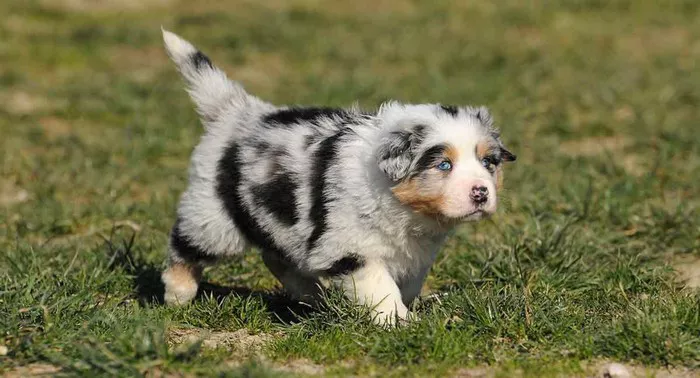Australian Shepherds are a popular breed of dog that is known for their intelligence, loyalty, and high energy levels. Like all breeds of dogs, Australian Shepherds go through a growth period during their first year of life. During this time, it’s important to ensure that they are receiving proper nutrition and exercise to support their growth and development. One important aspect of this growth period is the closure of their growth plates. In this article, we will explore when Australian Shepherd growth plates close and why this is important for their health.
What are Growth Plates?
Growth plates, also known as epiphyseal plates, are areas of cartilage at the ends of long bones in puppies and young dogs. These growth plates are responsible for the growth and development of bones, and they play an important role in determining the size and shape of a dog’s body. As a puppy grows and develops, their growth plates gradually close, and the cartilage is replaced by bone.
Why is the Closure of Growth Plates Important?
The closure of growth plates is an important milestone in a dog’s development. Once the growth plates have closed, the bones are no longer able to grow in length. This means that the size and shape of a dog’s body are largely determined by the time their growth plates close. If a dog is overfed or under-exercised during this period, it can lead to problems with their bone development, such as joint problems or skeletal deformities.
When Do Australian Shepherd Growth Plates Close?
The closure of growth plates in Australian Shepherds varies depending on their gender and size. In general, female Australian Shepherds tend to mature faster than males, and smaller dogs tend to mature faster than larger dogs. Here is a general timeline for when Australian Shepherd growth plates close:
Small male Australian Shepherds: 10-12 months
Small female Australian Shepherds: 8-10 months
Medium male Australian Shepherds: 12-14 months
Medium female Australian Shepherds: 10-12 months
Large male Australian Shepherds: 14-16 months
Large female Australian Shepherds: 12-14 months
It’s important to note that these are general guidelines, and the exact timing of growth plate closure can vary depending on the individual dog.
Health Problems Are Australian Shepherds Prone To?
As mentioned earlier, proper nutrition and exercise during the growth period are important for the development of healthy bones and joints in Australian Shepherds. Failure to provide proper nutrition and exercise can lead to a variety of health problems, including joint problems and skeletal deformities. Some of the health problems that Australian Shepherds are prone to include:
Hip Dysplasia: Hip dysplasia is a condition where the hip joint does not develop properly, which can lead to arthritis and other joint problems.
Elbow Dysplasia: Elbow dysplasia is a condition where the elbow joint does not develop properly, which can lead to arthritis and other joint problems.
Patellar Luxation: Patellar luxation is a condition where the kneecap slips out of place, which can cause pain and lameness.
Osteochondrosis Dissecans (OCD): OCD is a condition where the cartilage in the joints does not develop properly, which can lead to joint pain and lameness.
Panosteitis: Panosteitis is a condition where there is inflammation of the long bones in a dog’s legs, which can cause pain and lameness.
Preventing Health Problems in Australian Shepherds
To prevent health problems in Australian Shepherds, it’s important to provide them with proper nutrition and exercise during their growth period. This includes feeding them a balanced diet that is appropriate for their age, weight, and activity level, as well as providing them with plenty of opportunities to exercise and play.
It’s also important to ensure that Australian Shepherds receive regular veterinary checkups, especially during their growth period. Your veterinarian can monitor your dog’s growth and development and identify any potential health problems early on.
Conclusion
In conclusion, the closure of growth plates is an important milestone in a dog’s development, and it’s important to provide Australian Shepherds with proper nutrition and exercise during this period to prevent health problems later in life. The timing of growth plate closure in Australian Shepherds varies depending on their gender and size, and it’s important to monitor their growth and development to ensure that they are growing and developing properly. By providing your Australian Shepherd with proper care and attention during their growth period, you can help ensure that they grow up to be healthy and happy dogs.
FAQs
How to tell if a dog’s growth plates are closed?
A veterinarian can determine if a dog’s growth plates are closed through X-rays, which can show the degree of ossification (hardening) of the growth plates. Closed growth plates indicate that the dog has reached skeletal maturity.
At what age do puppies’ growth plates close?
Puppies’ growth plates typically close between 12 to 18 months of age, although the exact timing can vary depending on factors such as breed, size, and individual growth rate.
At what age is an Australian Shepherd full grown?
Australian Shepherds are considered fully grown around 18 to 24 months of age. However, some individual dogs may continue to fill out and develop muscle mass beyond this timeframe.
At what age do Australian Shepherds slow down?
Australian Shepherds may begin to slow down and exhibit less intense activity levels as they reach maturity, typically around 2 to 3 years of age. However, they will still require regular exercise and mental stimulation to maintain their health and well-being throughout their lives.


